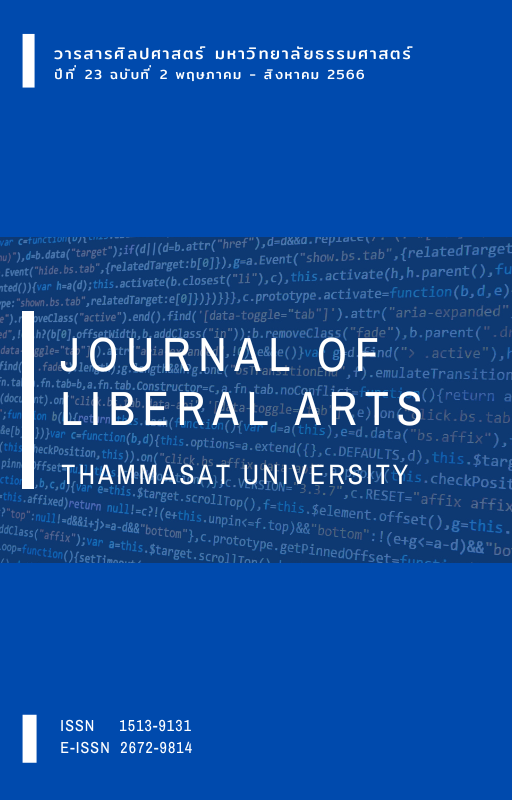ความคาดหวังและความพึงพอใจของผู้เรียนต่อการจัดการเรียนการสอนรายวิชาการฟัง-พูดภาษาญี่ปุ่นโดยผู้สอนชาวไทย
Main Article Content
บทคัดย่อ
งานวิจัยนี้ได้ศึกษาความคาดหวัง และความพึงพอใจของนักศึกษาวิชาเอกภาษาญี่ปุ่นชาวไทยต่อการจัดการเรียนการสอนรายวิชาฟัง-พูดภาษาญี่ปุ่นโดยผู้สอนชาวไทย กลุ่มเป้าหมาย คือ นักศึกษาชั้นปีที่ 1 จำนวน 26 คน ผลการวิเคราะห์ข้อมูลพบว่า สำหรับการใช้ภาษาของผู้สอน กลุ่มเป้าหมายร้อยละ 73 คาดหวังให้ผู้สอนใช้ภาษาญี่ปุ่นเป็นหลัก และร้อยละ 27 คาดหวังให้ผู้สอนใช้ภาษาญี่ปุ่นควบคู่กับภาษาไทยในการจัดการเรียนการสอน สำหรับกิจกรรมในชั้นเรียนที่กลุ่มเป้าหมายคาดหวัง 3 อันดับแรก ได้แก่ (1) การฟังจับใจความ (2) การฝึกโต้ตอบสนทนากับเพื่อน และ (3) การฝึกออกเสียง ด้านความพึงพอใจ พบว่า กลุ่มเป้าหมายมีความพึงพอใจต่อการจัดการเรียนการสอนในรายวิชา “การฟัง-พูดภาษาญี่ปุ่นพื้นฐาน 1” ในระดับมากที่สุด โดยกิจกรรม 3 อันดับแรกที่กลุ่มเป้าหมายพึงพอใจสูงสุด ได้แก่ การพูด speech 3 นาที การเล่นเกม และการเขียนสะท้อนคิด นักศึกษากลุ่มเป้าหมายคิดว่าบรรยากาศในชั้นเรียนผ่อนคลายเป็นกันเอง กิจกรรมในการจัดการเรียนการสอนมีความหลากหลาย สนุกสนาน ทำให้รู้สึกอยากเรียน
Downloads
Article Details

อนุญาตภายใต้เงื่อนไข Creative Commons Attribution-NonCommercial-NoDerivatives 4.0 International License.
เอกสารอ้างอิง
คุณัชญ์ สมชนะกิจ, พจนา เดชสถิต, ทาคายูกิ คากิซากิ, และ ชวเลิศ เทพประดิษฐ์. (2560). สภาพปัญหาและการปรับตัวของผู้สอนภาษาญี่ปุ่นระดับอุดมศึกษาในจังหวัดชายแดนใต้. วารสารมนุษยศาสตร์สังคมศาสตร์ มหาวิทยาลัยทักษิณ, 12(1), 181-205.
บุญชม ศรีสะอาด. (2539). การแปลผลเมื่อใช้เครื่องมือรวบรวมข้อมูลแบบมาตราส่วนประมาณค่า. วารสารการวัดผลการศึกษามหาวิทยาลัยมหาสารคาม, 2(1), 64-70.
พรเทพ คัชมาตย์. (2560). การศึกษาทัศนคติของนักศึกษาสาขาวิชาภาษาอังกฤษที่มีต่อความหลากหลายทางภาษาอังกฤษของโลก อาจารย์สอนภาษาอังกฤษที่ไม่ใช่เจ้าของภาษา และอาจารย์เจ้าของภาษา: กรณีศึกษามหาวิทยาลัยราชภัฏเทพสตรี. ใน มหาวิทยาลัย ราชภัฏพิบูลสงคราม, รายงานสืบเนื่องการประชุมสัมมนาวิชาการ (Proceedings) การนำเสนอผลงานวิจัยระดับชาติ เครือข่ายบัณฑิตศึกษา มหาวิทยาลัยราชภัฏภาคเหนือ ครั้งที่ 17 (น. 1225-1238). มหาวิทยาลัยราชภัฏพิบูลสงคราม.
ภรณีย์ พินันโสตติกุล และ Yumiko Yamamoto. (2562). ทัศนคติของผู้เรียนต่อการจัดการเรียนการสอนร่วมระหว่างผู้สอนชาวไทยและชาวญี่ปุ่น. วารสารเครือข่ายญี่ปุ่นศึกษา, 9(2), 26-40.
ยุพกา ฟูกุชิม่า. (2562). ทัศนคติของผู้เรียนต่อการบรรยายด้วยภาษาญี่ปุ่นของผู้สอนชาวไทยในรายวิชาการอ่านภาษาญี่ปุ่นขั้นสูง. วารสารเครือข่ายญี่ปุ่นศึกษา, 9(1), 25-48.
ยุพกา ฟูกุชิม่า และ ริกะ อินะงะขิ. (2562). ความเชื่อ และความคาดหวังของผู้เรียนภาษาญี่ปุ่นชาวไทยต่อชั้นเรียนภาษาญี่ปุ่น ครูภาษาญี่ปุ่น และบทบาทของผู้สอน. วารสารเครือข่ายญี่ปุ่นศึกษา, 9(2), 1-25.
ศฬิษา วิทยาศรัย และ สมบูรณ์ พจน์ประสาท. (2019). การเปรียบเทียบความคิดเห็นและผลสัมฤทธิ์ทางภาษาอังกฤษของนักศึกษาที่เรียนกับอาจารย์เจ้าของภาษาและอาจารย์ชาวไทย. Veridian E-Journal, Silpakorn University (Humanities, Social Sciences and arts), 12(6), 103-121.
อัษฎายุทธ ชูศรี. (2012). การใช้ภาษาญี่ปุ่นในการบรรยายโดยผู้สอนชาวไทย กรณีศึกษาการสอนวิชาเนื้อหาระดับกลางสูงในจุฬาลงกรณ์มหาวิทยาลัย. วารสารเจแปนฟาวน์เดชั่น กรุงเทพฯ, 9, 139-144.
เอื้อมพร หลินเจริญ. (2555). เทคนิคการวิเคราะห์ข้อมูลเชิงคุณภาพ. วารสารการวัดผลการศึกษา, 17(1), 17-29.
Abe, Y., & Yokoyama, N. (1991). Kaigai nihongokyooshi chookikenshuu no kadai: Gaikokujin nihongokyooshi no riten o ikashita kyoojuhoo o motomete. Nihongo Kokusai Center Kiyoo, 1, 53-74.
Boonserm, S. (2012). Japanese language learners’ perception toward “classroom activities” in case of Thailand university students: In perspective of “preference” “enjoyment” and “effectiveness”. Japanese Language Education Methods, 19(2), 44-45. (in Japanese)
Cardozo, R. (1965). An experimental study of customer effort, expectation and satisfaction. Journal of Marketing Research, 2(3), 244–249.
Kaiser, S. (1995). The role of the non-native teacher in the teaching of Japanese: Towards the language classroom as a venue for intercultural education. Journal of Japanese Language Teaching, 10, 95-106.
Kongjit, S., & Yoshida, N. (2012). Team Teaching ni okeru neetibu kyooshi to non-neetibu kyooshi no yakuwari buntan: Chiangmai daigaku shokyuu nihongo kurasu no taijin gakushuusha no kitai. Japanese Language Education Bulletin Japan Foundation Bangkok, 9, 129-138. (in Japanese)
Laohaburanakit Katagiri, K., Iketani, K., Katagiri, J., & Nakayama, E. (2009, November). Experiences and Hon’ne of Thai teachers on collaboration with Japanese teachers in Japanese language education: With a special reference to the ‘Accuracy-Focus’ views of teaching [Paper presentation]. In Institute of Teacher Education Malaysia, The 21st Century Approach to Japanese Studies Programmes Towards the Creation of a New Academic Network between Japan and Southeast Asia, Kuala Lumpur, Malaysia.
Nagasaka, M., & Kida, M. (2011). Chuugoku no daigaku no nihongojugyoo ni okeru kaiwashidoo ni kansuru choosa: Chuu-Jookyuu reberu o taishoo to shita kyooshitsukatsudoo no jittai to kyooshi no ishiki. The Japan Foundation Japanese-Language Education Bulletin, 7, 43-57. (in Japanese)
Okamoto, K. (2010). “Native” and “non-native” teachers’ beliefs and their teaching practice in a team teaching situation. Handai nihongo kenkyuu, 22, 205-235. (in Japanese)
Sallivan, C. (2016). Student Preferences and Expectations in English Classroom. Gengobunka, 52, 35-47.
Sasajima, S., & Borg, S. (2009). Gengo kyooshi ninchi no kenkyuu. Kaitakusha.
Shin, J. E. (2006). Nihon kokunai no hibogowasha nihongo kyooshi ni taisuru gakushuusha no henyoo: Waseda daigaku no shokyuu jissen o tooshite. Kooza Nihongo Kyooiku, 42, 60-81. (in Japanese)
Takahashi, M. (2015). View of Japanese-language education in Japan by non-native teachers: Proposal for diversification of language teachers in multicultural symbiotic societies. Journal for the Study of Japanese Language Education Practice, 2, 104-113. (in Japanese)
Takahashi, M. (2019). An overview of the cognition of non-native language teachers: Do they share their native languages and cultural backgrounds with students?. Showajoshi daigaku daigakuin gengokyooiku komyunikeeshon kenkyuu, 13, 1-17.
Yokota, T. (2013). A Survey of foreign students’ view towards Non-native Japanese language teachers in Japan. In University of Toronto, 2013 CAJLE Annual Conference Proceedings (pp. 322-331). https://www.cajle.ca/conference-proceedings/cajle2013-proceedings/ (in Japanese)
Yen, H.-Y. (2003a). Opinions on Teacher's Use of the Mother Tongue in Japanese Conversation Classes in Universities in Taiwan: Based on the opinion poll among teachers and learners in different semesters. Bulletin of the Department of Teaching Japanese as a Second Language, Hiroshima University, 13, 59-66. (in Japanese)
Yen, H.-Y. (2003b). Opinions on Teacher's Use of the Mother Tongue in Japanese Conversation Classes: from the result of questionnaire research at seven universities in Taiwan. The bulletin of Japanese Curriculum Research and Development, 25(4), 59-68. (in Japanese)
Wu, Y.-C., Hsieh, L.-F., & Lu, J.-J. (2015). What’s The Relationship Between Learning Satisfaction and Continuing Learning Intention?. Procedia–Social and Behavioral Science, 191, 2849-2854.


